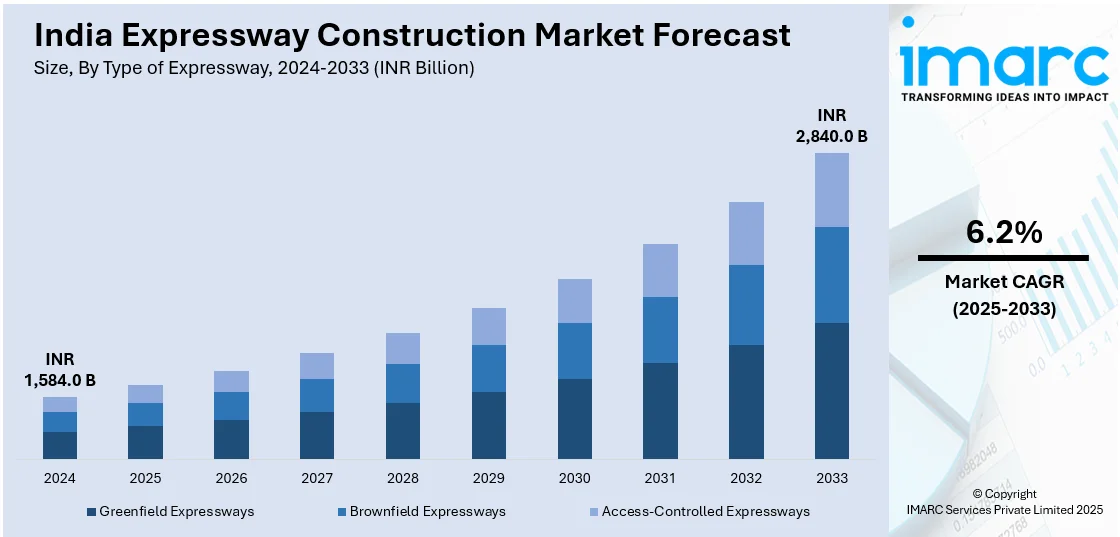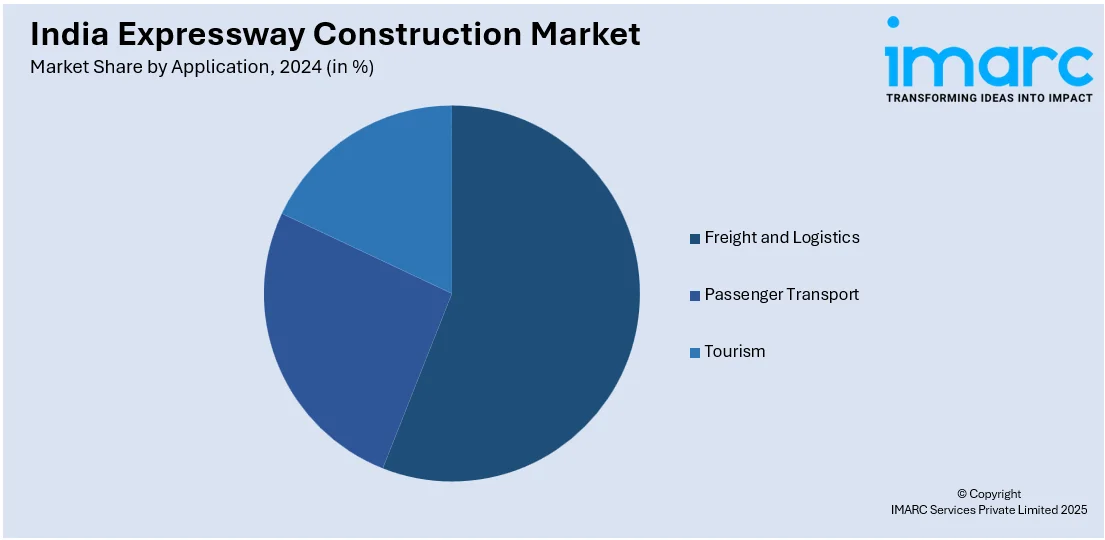
India Expressway Construction Market Size, Share, Trends and Forecast by Type of Expressway, Construction Type, Construction Material, Technology & Innovation, Application, and Region, 2025-2033
India Expressway Construction Market Size and Share:
The India expressway construction market size reached INR 1,584.0 Billion in 2024. Looking forward, IMARC Group expects the market to reach INR 2,840.0 Billion by 2033, exhibiting a growth rate (CAGR) of 6.2% during 2025-2033. The market is fueled by government infrastructure initiatives, rapid urbanization, rising traffic demand, increased private sector and foreign investments, and advancements in construction technology. Moreover, programs like Bharatmala Pariyojana, smart highway innovations, and public-private partnerships (PPPs) are accelerating expressway development, thus further increasing the India expressway construction market share.
|
Report Attribute
|
Key Statistics
|
|---|---|
|
Base Year
|
2024
|
|
Forecast Years
|
2025-2033
|
|
Historical Years
|
2019-2024
|
| Market Size in 2024 | INR 1,584.0 Billion |
| Market Forecast in 2033 | INR 2,840.0 Billion |
| Market Growth Rate 2025-2033 | 6.2% |
India Expressway Construction Market Trends:
Government Initiatives and Infrastructure Investments
The Indian government is heavily investing in expressway construction through programs like Bharatmala Pariyojana, the National Infrastructure Pipeline (NIP), and Gati Shakti. These initiatives aim to improve connectivity, reduce travel time, and boost economic growth. Increased budget allocations for highway projects, the introduction of public-private partnerships (PPPs), and faster land acquisition processes have accelerated expressway development. The government is also emphasizing green and smart highways, incorporating electric vehicle (EV) charging stations, intelligent transport systems (ITS), and sustainable materials, further driving the India expressway construction market growth in the sector. For instance, in March 2025, Prime Minister’s Cabinet Committee on Economic Affairs approved a six-lane Greenfield National Highway project in Maharashtra that will improve connectivity between Chowk and JNPA Port (Pagote). The 29.219-kilometer highway, which would be built using the Build, Operate, and Transfer (BOT) model and be in line with the PM GatiShakti National Master Plan, which emphasizes integrated infrastructure development, will cost a total of INR 45 Billion. Rising container traffic at JNPA Port and the expected increase in travel demand when Navi Mumbai International Airport opens were the driving forces for the project's proposal.

To get more information on this market, Request Sample
Private Sector and Foreign Investments
The expansion of expressway projects is being fueled by increased participation from private companies and foreign investors. Public-private partnerships (PPPs) and foreign direct investment (FDI) in road infrastructure are attracting leading construction firms and global players. The introduction of the Hybrid Annuity Model (HAM) and Build-Operate-Transfer (BOT) models has made expressway projects more financially viable. Additionally, institutions like the National Investment and Infrastructure Fund (NIIF) and global investors are supporting large-scale road development projects, creating a positive India expressway construction market outlook.
Expansion of Connectivity
India's expressway construction is significantly enhancing regional connectivity, linking major cities, industrial hubs, and rural areas with high-speed road networks. These expressways are reducing travel time, improving logistics efficiency, and facilitating smoother transportation of goods and passengers. Key projects like the Delhi-Mumbai Expressway and Bengaluru-Chennai Expressway are expected to drive economic growth by improving access to markets and reducing transportation costs. Additionally, better road connectivity is boosting tourism and real estate development along expressway corridors. The integration of expressways with industrial zones and smart cities further strengthens economic activity. By improving intra-state and inter-state travel, these road networks are playing a crucial role in India's infrastructure modernization, supporting trade, commerce, and overall regional development.
India Expressway Construction Market Segmentation:
IMARC Group provides an analysis of the key trends in each segment of the market, along with forecasts at the regional level for 2025-2033. Our report has categorized the market based on the type of expressway, construction type, construction material, technology & innovation, and application.
Type of Expressway Insights:
- Greenfield Expressways
- Brownfield Expressways
- Access-Controlled Expressways
The report has provided a detailed breakup and analysis of the market based on the type of expressway. This includes greenfield expressways, brownfield expressways, and access-controlled expressways.
Construction Type Insights:
- EPC (Engineering, Procurement, and Construction)
- PPP (Public-Private Partnership)
- Hybrid Annuity Model (HAM)
- BOT (Build-Operate-Transfer)
A detailed breakup and analysis of the market based on the construction type have also been provided in the report. This includes EPC (Engineering, Procurement, and Construction), PPP (Public-Private Partnership), Hybrid Annuity Model (HAM), and BOT (Build-Operate-Transfer).
Construction Material Insights:
- Concrete Expressways
- Asphalt Expressways
- Hybrid & Composite Expressways
A detailed breakup and analysis of the market based on the construction material have also been provided in the report. This includes concrete expressways, asphalt expressways, and hybrid & composite expressways.
Technology & Innovation Insights:
- Smart Expressways
- Sustainable & Eco-friendly Construction Techniques
- Intelligent Traffic Management Systems (ITS)
A detailed breakup and analysis of the market based on technology & innovation have also been provided in the report. This includes smart expressways, sustainable & eco-friendly construction techniques, and intelligent traffic management systems (ITS).
Application Insights:

- Freight and Logistics
- Passenger Transport
- Tourism
A detailed breakup and analysis of the market based on the application have also been provided in the report. This includes freight and logistics, passenger transport, and tourism.
Regional Insights:
- North India
- South India
- East India
- West India
The report has also provided a comprehensive analysis of all the major regional markets, which include North India, South India, East India, and West India.
Competitive Landscape:
The market research report has also provided a comprehensive analysis of the competitive landscape. Competitive analysis such as market structure, key player positioning, top winning strategies, competitive dashboard, and company evaluation quadrant has been covered in the report. Also, detailed profiles of all major companies have been provided.
India Expressway Construction Market News:
- In April 2025, the Noida Authority approved plans for a new expressway to connect Noida and Greater Noida. This project aims to reduce traffic congestion in the area. Two design options are being considered: an eight-lane ground expressway or a six-lane elevated road. The initiative is prompted by rapid development in the region and the construction of a new airport.
- In December 2024, Union Minister of India declared that the Delhi-Dehradun expressway would be finished in the next three months, cutting the travel time between the two cities to two hours.
India Expressway Construction Market Report Coverage:
| Report Features | Details |
|---|---|
| Base Year of the Analysis | 2024 |
| Historical Period | 2019-2024 |
| Forecast Period | 2025-2033 |
| Units | INR Billion |
| Scope of the Report |
Exploration of Historical Trends and Market Outlook, Industry Catalysts and Challenges, Segment-Wise Historical and Future Market Assessment:
|
| Types of Expressways Covered | Greenfield Expressways, Brownfield Expressways, Access-Controlled Expressways |
| Construction Types Covered | EPC (Engineering, Procurement, and Construction), PPP (Public-Private Partnership), Hybrid Annuity Model (HAM), BOT (Build-Operate-Transfer) |
| Construction Materials Covered | Concrete Expressways, Asphalt Expressways, Hybrid & Composite Expressways |
| Technology & Innovations Covered | Smart Expressways, Sustainable & Eco-friendly Construction Techniques, Intelligent Traffic Management Systems (ITS) |
| Applications Covered | Freight and Logistics, Passenger Transport, Tourism |
| Regions Covered | North India, South India, East India, West India |
| Customization Scope | 10% Free Customization |
| Post-Sale Analyst Support | 10-12 Weeks |
| Delivery Format | PDF and Excel through Email (We can also provide the editable version of the report in PPT/Word format on special request) |
Key Benefits for Stakeholders:
- IMARC’s industry report offers a comprehensive quantitative analysis of various market segments, historical and current market trends, market forecasts, and dynamics of the India expressway construction market from 2019-2033.
- The research report provides the latest information on the market drivers, challenges, and opportunities in the India expressway construction market.
- Porter's five forces analysis assist stakeholders in assessing the impact of new entrants, competitive rivalry, supplier power, buyer power, and the threat of substitution. It helps stakeholders to analyze the level of competition within the India expressway construction industry and its attractiveness.
- Competitive landscape allows stakeholders to understand their competitive environment and provides an insight into the current positions of key players in the market.
Key Questions Answered in This Report
The expressway construction market in India was valued at INR 1,584.0 Billion in 2024.
The India expressway construction market is projected to exhibit a CAGR of 6.2% during 2025-2033, reaching a value of INR 2,840.0 Billion by 2033.
The India expressway construction market is driven by urban developments, government infrastructure initiatives, increasing vehicle ownership, rising demand for efficient freight corridors, and significant foreign direct investment. These factors collectively boost connectivity, reduce travel time, and support economic growth.
Need more help?
- Speak to our experienced analysts for insights on the current market scenarios.
- Include additional segments and countries to customize the report as per your requirement.
- Gain an unparalleled competitive advantage in your domain by understanding how to utilize the report and positively impacting your operations and revenue.
- For further assistance, please connect with our analysts.
 Request Customization
Request Customization
 Speak to an Analyst
Speak to an Analyst
 Request Brochure
Request Brochure
 Inquire Before Buying
Inquire Before Buying




.webp)




.webp)












